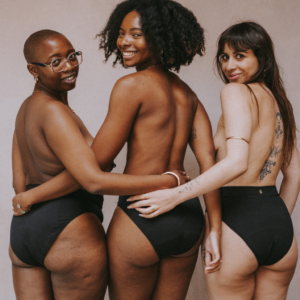The idea of recycled fashion is not new, however, it has become much more popular within recent years. A growing number of brands are switching to recycled versions of fibers, often advertising these clothes as the “more sustainable” or “conscious” choice.
This sustainable fashion option has become the trendy new way to be more conscious about your clothing. Consumers now have access to a wide variety of recycled fashion options – from in-store campaigns to door-step collection.
You can recycle synthetic fibers such as Polyester and Viscose into brand new products, and you can also recycle natural fibers such as Cotton. Recycling has become popular with the aim to create a more circular economy for the future of the fashion industry.
Read on to find out more about recycled fashion and how it has impacted sustainable fabric markets, and whether this trend is really the future for sustainable fashion.
How to begin the recycling movement
As mentioned in our 5 tips for a sustainable brands blog post – recycling and upcycling do not have to just cover just clothing itself, it can start within the mindset of your organisation.
It is not simply about manufacturing and designing clothes ethically using recycled fabrics – sustainability starts with the small things your organisation does. When it comes to your everyday recycling, make sure that it is as easy as possible for your employees to carry out, as recycling in all aspects helps the fashion industry.
Place recycling bins in all offices and staff areas so that it isn’t a chore to recycle (both waste and garment bins!) By encouraging recycling amongst your team, it will eventually become a part of the workplace culture, which is exactly what you want when trying to become a more sustainable brand.
Another way to kick off a recycling forward approach is to try out a recycling scheme. Many brands have been incorporating schemes and rewards into their stores in order to get their staff and consumers recycling properly.
Boots offer £5 worth of Advantage Card points if you recycle at least five qualifying items, and M&S have partnered with Oxfam to recycle textiles through their Shwopping partnership with the potential to receive £5 to spend in-store.
How does clothing recycling work?
The majority of textiles are fully recyclable – items including garments, bedding, towels, napkins, soft furnishings and more.
Textiles will be given to a recycling company either through clothing banks, charity collection services such as The British Heart Foundation, or company recycling schemes such as high street retailers Primark.
After being sent to the recycling centres they are sorted by material and colour, processed through machines that shred the garments back down to raw fibers, cleaned thoroughly to ensure that the fibers are fit for reproduction , re-spun into new textiles, and reused to make garments, insulation, and other products depending on the quality of the recycled fibers.
The Environmental Protection Agency states that around ‘17 million tons of textile municipal solid waste (MSW) was generated in 2018, which represents 5.8% of total MSW generation. The recycling rate for textiles was 14.7%, meaning 2.5 million tons of textiles were recycled. The other 14.5 million tons were either combusted or sent to landfills.
These recycled fibres go on to create sustainable fabric used within a large array of different brands today, from recycled swimwear companies to larger brands sustainable fashion collections such as H&M’s Conscious range.
Cutting edge fabric recycling
There are many cutting-edge products on the market today, from turning fishing nets and tyres into fully formed materials ready for manufacturing. From plastic bottles to discarded X-rays and film, almost every kind of waste is potential to designers!
Tyres
At the digital presentation for the Performance Days fabric fair, a company producing sustainable fabrics made of post-consumer nylon obtained from tyres presented their ideas. The tyres are being recycled in a process called ChemCyling developed by BASF.
This recycling platform can use both mixed plastic waste from municipal waste collections and discarded automotive tyres. The waste is chemically recycled into a pyrolysis oil which replaces crude fossil oil as a feedstock. The recycled amount is allocated in the product via a certified mass balance approach.
The Long Advance fabric consists of 7% elastane and 93% recycled polyamide, both reducing the need for synthetic fabrics and also ensuring that tyre waste is recycled in a meaningful way.
Fishing nets
Every year more than 25,000 fishing nets are reported lost or discarded. Most of the time, these are broken and are no longer used for fishing. Fishing nets are made of 100% synthetic materials and will never break down, causing a huge amount of waste in our oceans.
It is increasingly important that we are looking after our oceans so that we can protect marine animals and ecosystems that are essential to keeping our planet healthy, as currently there are global problems related to this.
Fishing nets can trap animals such as sharks, dolphins, fish and turtles and clearing them up is a huge help to the environment. In countries such as the Philippines, local fishers collect old nets to be recycled into carpet tiles. However, these fishing nets can also be used in the fashion industry. Company Girlfriend has created leggings, bras and tops from recycled nylon in fishing nets! They have over 500k followers all buying their recycled sustainable fabrics in innovative new products.
Why is recycling important?
An estimated 70 pounds of textiles can be thrown away each year in the US alone, this coming mostly from fast fashion stores such as Boohoo and Shein, with over-consumption of clothing being rife within society today.
Fast fashion trend cycles have made it acceptable to wear a new outfit for every occasion, and this means that when the person buying the garments is done with them, they are simply thrown into the rubbish only to end up in a landfill.
Due to the fact that the majority of cheap clothing today is 100% synthetic, the products will never bio-degrade, which is extremely harmful for the environment.
The fast fashion cycle also emits greenhouse gases – carbon emissions result from all stages of a garments lifecycle, and this can be a huge impact on carbon footprint around the globe.
Recycling textiles is extremely important to reduce greenhouse gas emissions and to cut down on pollutants and waste in the environment.
When you go shopping for new textiles, consider sustainable alternatives. Look for textiles that are high-quality and can last you a long time. Prioritize companies that use sustainable materials like organic or recycled cotton.
When possible, repair any damage to your textiles instead of swapping them for new items and consider shopping second-hand. Think of a completely circular economy, with reuse, repurposing and recycling at the heart.
Brands incorporating recycled sustainable fabrics
Ecoalf: @ecoalf. Born of frustration with the excessive use of the world’s natural resources, and the amount of waste produced by industrialized countries, Spanish brand Ecoalf was founded on the principles of recycling. The intent to create a truly sustainable fashion brand, started at the source, and as the result of limited choices in the marketplace of 100% recycled materials.
“Discarded fishing nets, post-consumer plastic bottles, worn-out tires, post-industrial cotton, and even used coffee grinds become our outerwear, swimsuits, sneakers and accessories. In order to ensure 100% transparency and provide the highest levels of quality, our team manages the full process from waste collection to recycling technologies, manufacture, design and retail.”
Re;code: @recode. Re;code are a Korean brand specialising in upcycling. Each item in the collection has a story, and creates a new culture of value in place of waste. They work with the mentally handicapped and the ‘Goodwill Store’ to deconstruct salvaged materials ready for reinterpretation and redesign
“We disassemble and re-commercialise ready-made products. People might find it surprising that we use industrial materials such as seat covers, airbags, and fabric linings that make up a car’s interior, waste that is collected from our sister companies within the Kolon group, to design jackets, bags and laptop cases.”
See the full list here. If you would like to find out more about sustainable fashion, sustainable fabrics, circular economies or other sustainable fashion-related content, check out our blog’s page.




